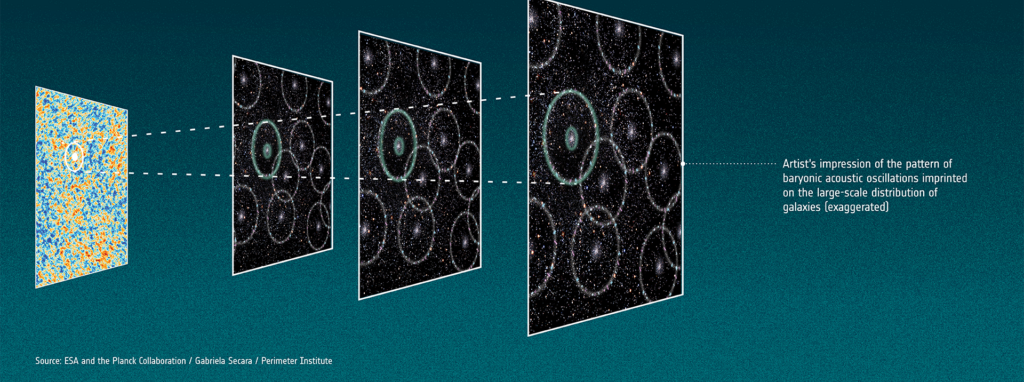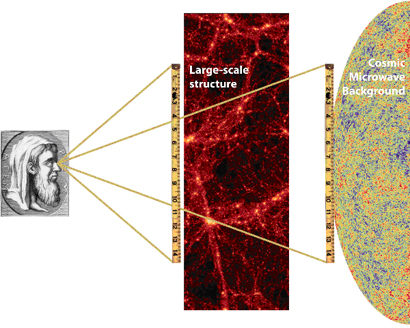Hidden in the large-scale structure of the Universe – the so-called cosmic web, subtle waves provide a priceless view on the cosmos, helping scientists highlight some of the mysteries about its structure, evolution, and its current accelerated expansion governed by dark energy. This phenomenon is known as Baryon Acoustic Oscillations (BAOs). To understand what they are, we must travel back in time to the early Universe! Are you ready?
Just after the Big Bang when the Universe was just a few hundred thousand years old, ordinary matter and radiation were tightly bound together forming a hot, dense plasma of particles and photons. A cosmic soup we do not advise you to drink! Within this chaos, some regions were already denser than others which, under gravitation, attracted the plasma around them. However, these movements due to gravitation were balanced out by the pressure generated by photons, leading to rebound movements. These opposite movements generated sound waves travelling in the early Universe and carrying matter, the same kind of waves one can see on the surface of a lake after throwing a rock.

Credit: ESA and the Planck Collaboration / Gabriela Secara / Perimeter Institute
As the Universe expanded, it became cooler and less dense, enabling atoms to form and light to travel freely throughout the Universe. This first light of the Universe can now be observed in the microwave domain: the Cosmic Microwave Background (CMB) observed by the Planck satellite for instance. As atoms form and photons are set free, there is no radiation pressure to oppose gravity anymore. Thus, the primordial sound waves could not propagate anymore as if they froze in place. As a consequence, matter stopped being carried away from their original location, typically a region that was with a larger density than average. Scientists can still identify the imprint of the BAO scale in the distribution of galaxies and galaxy clusters. In other words, the denser regions of matter imprinted in the early Universe correspond to the regions where we find the higher density of galaxies and galaxy clusters today. In that sense, BAOs are not just oscillations, they are somewhat an echo of the early Universe.
Even more interesting, these cosmic vibrations can be used as a cosmic ruler to measure and study the expansion history of the Universe. Indeed, by comparing this typical scale of about 500 million light years observed in the cosmic microwave background, and the same one seen in the distribution of galaxies at a different time, scientists can map the expansion history of the Universe. Therefore, BAOs offer crucial hints for Euclid scientists to unveil the nature of dark energy.

Credit: NASA, ESA, and R. Massey.
To measure BAOs, scientists will have access through Euclid to an unprecedented amount of high quality data observing billions of galaxies across the sky. Euclid has been designed specifically to unveil the dark Universe using gravitational weak lensing (see dedicated blog post) and BAOs, and therefore to study the distribution of the galaxies in the Universe. In other words, scientists need an accurate 3D spatial distribution of the galaxies throughout the Universe, and then to be able to estimate their distance. This estimation relies on the measure of redshifts in the galaxies’ spectra. This effect, similar to the Doppler effect, is experienced in our daily life with the passing of an ambulance for instance. When the ambulance gets closer, the sound gets higher. On the contrary, when the ambulance goes further away, we hear a deeper sound. So, when the ambulance goes away, the sound of the siren is shifted towards the lower wavelengths. This effect can also be seen in the light of galaxies. With the expansion, the galaxies are moving away from us and therefore, the wavelengths are shifted to lower frequencies, and appear then redder. This redshift can be measured accurately in the spectra of galaxies.
With the redshift measurements and the observed positions scientists can estimate the distances between galaxies located far away. However, this conversion from redshift and angles to distances is not so easy. It primarily depends on the velocities at which galaxies are moving with respect to our position. Given that galaxies are constantly receding due to the Universe’s ongoing expansion, the conversion between redshift and distances is influenced by the rate at which the Universe is expanding. The distant cosmic objects observed today are seen as when they were a long time ago, the time when its light began its journey towards us. Since the expansion is accelerating, scientists also need to know the expansion rate there was at that time. This is where the concept of the Baryon Acoustic Oscillations (BAOs) scale as cosmic ruler becomes invaluable. By measuring the same scale as separation between redshifts and the angles at which galaxies are seen, from objects that are observed at different times during the evolution of our Universe, we gain the means to chart the expansion history of the Universe at different cosmic epochs.
To probe dark energy using BAOs, Euclid is equipped with an instrument capable of dispersing the light of galaxies into spectra: the Near-Infrared Spectro-photometer (NISP). This instrument contains some grisms, which are optical pieces that enable to capture spectra of all the galaxies in the observed field. With NISP, Euclid scientists will be able to measure the redshift of about 35 million of galaxies over 6 years and, combined with weak lensing which is the other main probe, give away some secrets about the dark Universe.



